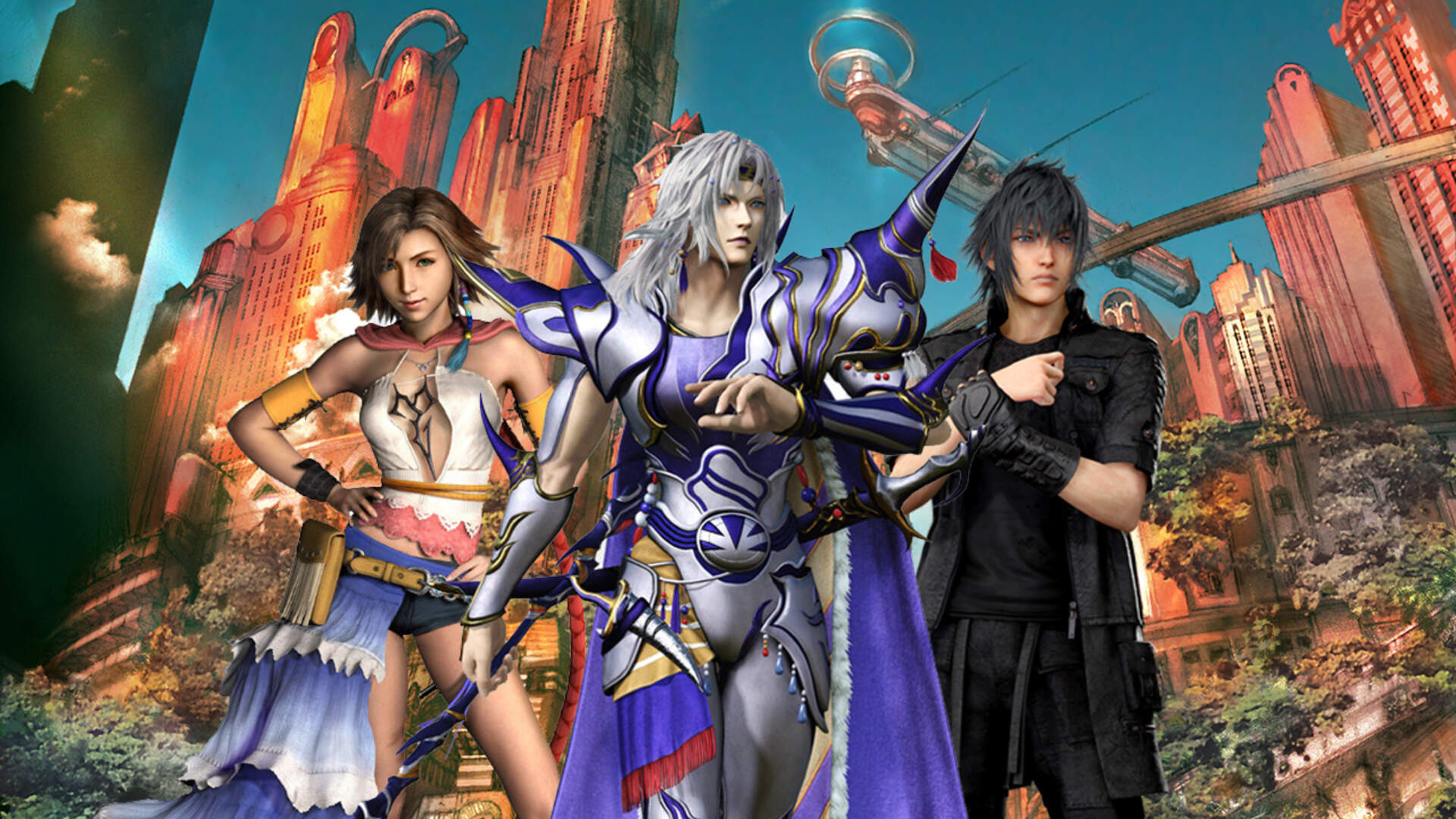Final Fantasy is a beloved Japanese anthology Science Fiction franchise that has captivated fans worldwide with its immersive stories and captivating gameplay. With a total of 21 main series games and numerous remakes and sequels, Final Fantasy has left an indelible mark on the RPG genre. In this article, we will explore the entire Final Fantasy series in chronological order, starting from its humble beginnings in 1987.
Final Fantasy 1- 1987
The first Final Fantasy game was released in 1987 for the Nintendo Entertainment System (NES). It introduced players to the world of Final Fantasy, where four Light Warriors embark on a quest to restore the crystals and bring light back to the world. The game’s turn-based combat system and deep character customization options set the foundation for the series’ future success.
Final Fantasy II -1988
In 1988, Final Fantasy II was released exclusively in Japan for the Family Computer (Famicom). This sequel introduced a more character-driven narrative, focusing on a group of orphans who join a rebellion against the Palamecia Empire. The game also introduced a unique progression system where character abilities improved based on their usage.
Final Fantasy III- 1990
Final Fantasy III, released in 1990 for the Family Computer, marked the series’ first international release. The game follows four chosen orphans who are tasked with saving the world from darkness. It introduced the innovative job system, allowing characters to change their classes and learn new abilities.
Final Fantasy IV-1991
In 1991, Final Fantasy IV (originally released as Final Fantasy II in the West) debuted for the Super Nintendo Entertainment System (SNES). The game follows Cecil, a dark knight who embarks on a journey to stop the sorcerer Golbez from obtaining powerful crystals. Final Fantasy IV introduced the Active Time Battle (ATB) system, adding a sense of urgency to combat.
Final Fantasy V- 1992
Final Fantasy V, released in 1992 for the Super Famicom, enhanced the series’ job system. Players control Bartz, a wanderer on a quest to prevent the sorcerer Exdeath from returning to power. The game allowed players to customize their characters by assigning different jobs and abilities.
Final Fantasy VI- 1994
Final Fantasy VI, released in 1994 for the SNES, is considered one of the series’ greatest achievements. The game features a diverse cast of 14 playable characters and a mature and complex storyline. Players join a rebellion against a totalitarian regime, exploring a world on the brink of destruction. Final Fantasy VI introduced groundbreaking graphics, a memorable soundtrack, and a deep, emotionally resonant narrative.
Final Fantasy VII- 1997
Final Fantasy VII, released in 1997 for the PlayStation, is one of the most iconic entries in the series. Players assume the role of Cloud Strife, a mercenary who joins an eco-terrorist group to prevent a mega-corporation from exploiting the planet’s life force. The game’s immersive world, memorable characters, and groundbreaking cinematic cutscenes revolutionized the RPG genre.
Final Fantasy VIII- 1999
Final Fantasy VIII, released in 1999 for the PlayStation, introduced a more realistic art style and a unique combat system called the Junction system. Players control Squall Leonhart, a mercenary caught in a conflict with a powerful sorceress. The game explores themes of love, fate, and personal identity, creating a captivating and emotional journey.
Final Fantasy IX- 2000
Final Fantasy IX, released in 2000 for the PlayStation, harkened back to the series’ roots with a return to a medieval-style setting. Players follow the thief Zidane Tribal as he joins a group of unlikely heroes to save the world from an evil queen. The game features a charming art style, memorable characters, and a deep exploration of themes such as identity and purpose.
Final Fantasy X- 2001
Final Fantasy X, released in 2001 for the PlayStation 2, introduced a fully voiced cast of characters and a dynamic, turn-based combat system. Players take on the role of Tidus, a young athlete who finds himself in the world of Spira, where he must team up with a group of guardians to defeat the monstrous entity known as Sin. The game’s emotional storyline and stunning visuals captivated players worldwide.
Final Fantasy XI-2002
Final Fantasy XI, released in 2002, marked the series’ first foray into the massively multiplayer online role-playing game (MMORPG) genre. Players enter the world of Vana’diel as adventurers, embarking on quests and battling powerful enemies. The game features a rich and immersive world, extensive character customization, and a robust community of players.
Final Fantasy X-2- 2003
Final Fantasy X-2, released in 2003, is a direct sequel to Final Fantasy X. Players assume the role of Yuna, who sets out on a mission to find her lost love, Tidus. The game introduced a more fast-paced combat system and allowed players to change character classes on the fly. Final Fantasy X-2 also explored themes of self-discovery and personal growth.
Final Fantasy XII- 2006
Final Fantasy XII, released in 2006 for the PlayStation 2, introduced a more open-world exploration and a real-time combat system. Players follow the story of Vaan, a young adventurer caught up in a war between empires. The game features a richly detailed world, complex political intrigue, and a diverse cast of characters.
Final Fantasy XII- Revenant Wings- 2007
Final Fantasy XII: Revenant Wings, released in 2007 for the Nintendo DS, is a sequel to Final Fantasy XII. Players control Vaan as he embarks on a sky pirate adventure, commanding a team of characters in strategy-based battles. The game expands on the lore and world of Final Fantasy XII while introducing new gameplay mechanics.
Final Fantasy XIII-2009
Final Fantasy XIII, released in 2009 for PlayStation 3, Xbox 360, and Windows, introduced a more action-oriented combat system. Players follow Lightning, a former soldier, as she fights against a totalitarian regime and uncovers the mysteries of a fal’Cie, powerful beings that control human destiny. The game features stunning visuals, a deep and intricate storyline, and a memorable cast of characters.
Final Fantasy XIV- 2010
Final Fantasy XIV, released in 2010, initially received a negative response due to technical issues and gameplay shortcomings. However, the game was reimagined and relaunched as Final Fantasy XIV: A Realm Reborn in 2013, garnering critical acclaim and a dedicated player base. The MMORPG takes place in the world of Eorzea, where players join forces to battle against the Garlean Empire and other threats.
Final Fantasy XIII-2-2011
Final Fantasy XIII-2, released in 2011, is a direct sequel to Final Fantasy XIII. Players follow Serah Farron, Lightning’s sister, as she traverses time and space to find her lost love, Noel Kreiss. The game features a non-linear narrative, time travel mechanics, and multiple endings based on player choices.
Lighting Returns- Final Fantasy XIII-2013
Lightning Returns: Final Fantasy XIII, released in 2013, concludes the Final Fantasy XIII trilogy. Players control Lightning as she awakens from a five-century slumber and embarks on a mission to save the world from impending doom. The game features a unique time management system and a combat system that focuses on fast-paced action.
Final Fantasy XIV- A Realm Reborn (ONLINE)-2013
Final Fantasy XIV: A Realm Reborn, released in 2013, is the reimagined version of Final Fantasy XIV. The game takes place in the world of Eorzea, where players create their characters and embark on epic adventures alongside other players. Final Fantasy XIV offers a vast and immersive world, rich storytelling, and a wide range of activities, such as quests, dungeons, and raids.
Final Fantasy XV-2016
Final Fantasy XV, released in 2016 for PlayStation 4, Xbox One, and Windows, takes players on a road trip with Noctis Lucis Caelum, the crown prince of Lucis. The game features an open-world environment, real-time combat, and a deep and emotional storyline. Final Fantasy XV offers a captivating blend of action, exploration, and character-driven narrative.
Final Fantasy VII Remake- 2020
Final Fantasy VII Remake, released in 2020 for PlayStation 4, is a reimagining of the original Final Fantasy VII. The game covers the Midgar section of the original game, expanding on the story and characters in greater detail. Final Fantasy VII Remake features updated graphics, a reworked combat system, and a fresh perspective on the beloved classic.
In conclusion, the Final Fantasy series has captivated gamers for decades with its rich storytelling, memorable characters, and innovative gameplay. From its humble beginnings in 1987 to the latest installment in 2020, each game in the series has contributed to the legacy of Final Fantasy and the RPG genre as a whole. Whether you’re a longtime fan or new to the series, there’s a Final Fantasy game waiting to transport you to a world of magic, adventure, and unforgettable experiences.
Wrapping Up
Here is a checklist of the Final Fantasy Games in their Chronological Order
- Final Fantasy I -1987
- Final Fantasy II -1988
- Final Fantasy III -1990
- Final Fantasy IV -1991
- Final Fantasy V -1992
- Final Fantasy VI -1994
- Final Fantasy VII – 1997
- Final Fantasy VIII -1999
- Final Fantasy IX – 2000
- Final Fantasy X -2001
- Final Fantasy XI – 2002
- Final Fantasy X-2 – 2003
- Final Fantasy XII – 2006
- Final Fantasy XII: Revenant Wings – 2007
- Final Fantasy XIII – 2009
- Final Fantasy XIV – 2010
- Final Fantasy XIII – 2 – 2011
- Lighting Returns: Final Fantasy XIII – 2013
- Final Fantasy XIV – A Realm Reborn – 2013
- Final Fantasy XV – 2016
- Final Fantasy VIII Remake – 2020
Conclusion
The Final Fantasy series has captivated generations of gamers with its rich storytelling, innovative gameplay mechanics, and memorable characters. From its humble beginnings on the NES to its latest installments on modern consoles, the franchise has continually pushed the boundaries of what an RPG can be. Whether you’re a fan of the classic 2D entries or prefer the modern 3D adventures, there’s a Final Fantasy game for everyone.
In this comprehensive guide, we’ve explored the origins of the series, the golden age of the 16-bit era, the transition to 3D graphics, and the modern era of Final Fantasy. Each entry in the series brings something unique to the table, whether it’s a groundbreaking battle system, a captivating story, or stunning visuals. With Final Fantasy XVI on the horizon, the future looks bright for this beloved franchise.
So grab your sword, don your armor, and embark on an epic journey through the world of Final Fantasy. Whether you’re a seasoned adventurer or new to the series, there’s a whole universe waiting to be explored. The crystals await, and the fate of the world is in your hands. Let the adventure begin!
Other Technical Reviews:- Reviews







